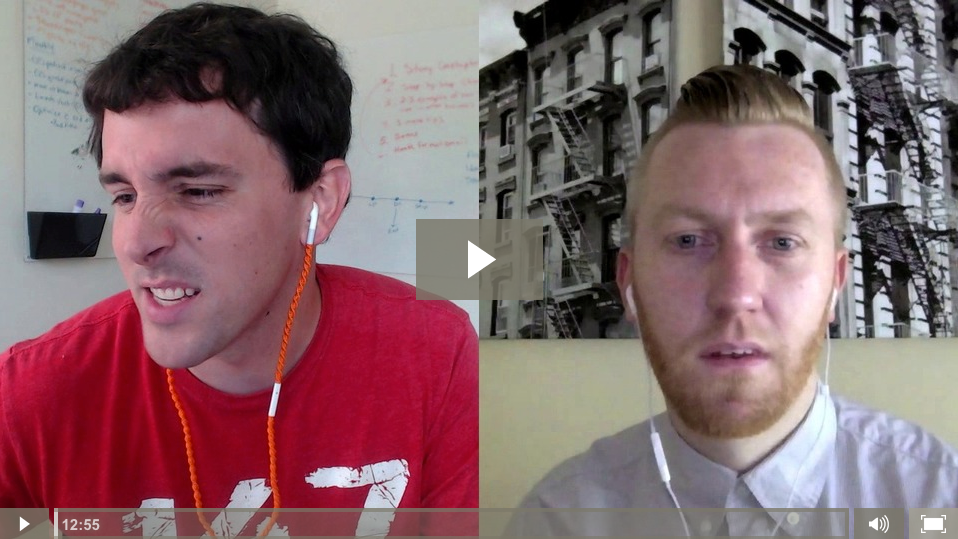9th grade.
That was when I took my first programming class.
14-year-old Bryan was bored out of his mind and retained exactly ZERO knowledge from that class.
Then 2 years ago when I decided to make my first web app I immediately regretted not paying attention. I had to hire a developer who could build it for me. That cost $2,000. Ugh.
Over the last 2 weeks, you’ve been learning about launch sequences. If you’re like me and haven’t been paying close attention, consider this your $2,000 moment.
STOP WHAT YOU ARE DOING AND PAY ATTENTION.
I made a quick 1-minute video to catch you up. Click here to watch it.
Onward…
Today we’re taking a look at a launch sequence put together by One Month.
One Month is a small startup that teaches people like you and me how to program. Their flagship program is One Month Rails.
A few weeks ago I noticed they were launching a new program, One Month Stripe. So, I started documenting their launch sequence.
Check it out.
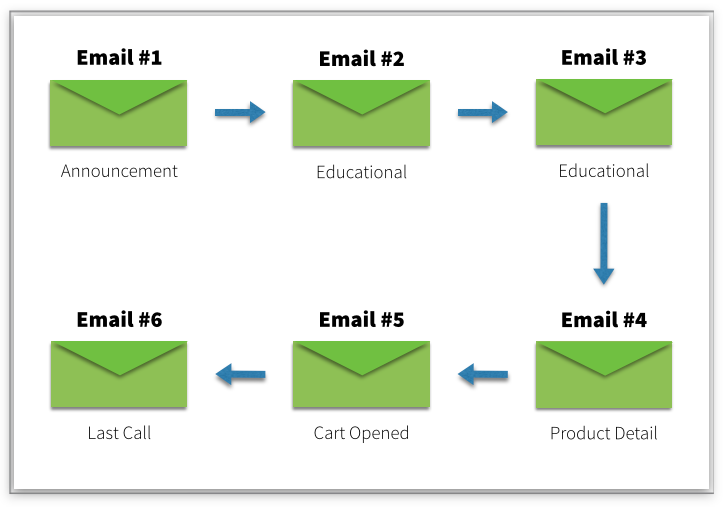
I jumped on the horn with their head of marketing the morning after the launch and we broke down the entire process.
Today you are getting two things:
- Full breakdown of the One Month Strip Launch, including emails and analysis.
- Behind-the-scenes interview with the One Month head of marketing.
Ready to go?
Oh!
One thing I forgot to tell you. Remember how Nathan Barry made $16,000 in 72 hours?
One Month did $15,000 in 24 hours with this launch.
Let’s jump in.
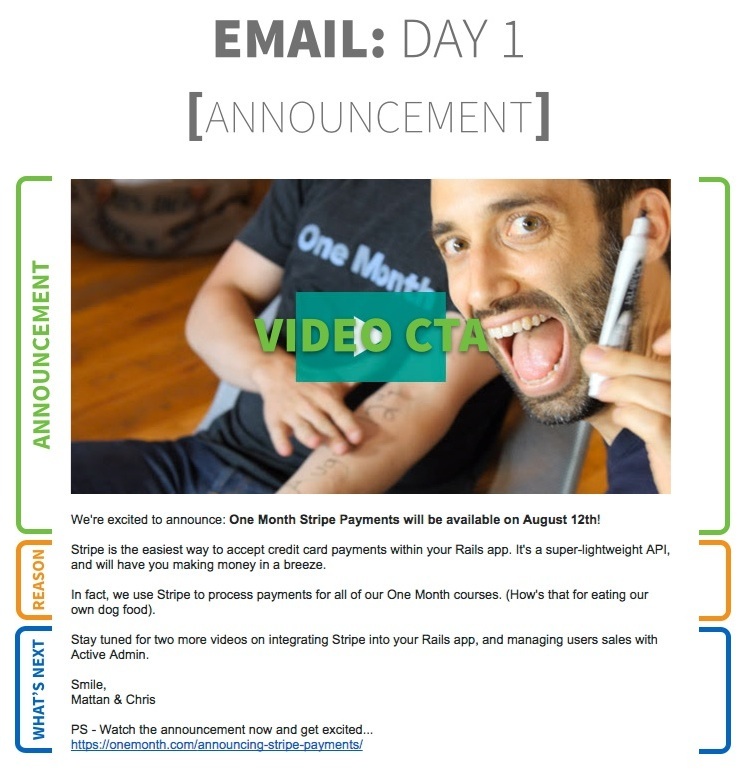
The first email in the launch sequence accomplished 3 things:
1. Announced the new Stripe course
2. Did NOT let the reader buy it immediately
3. Gave the date that it would be available
This approach is risky. Why?
Think about it this way…
Imagine you are a 19-year-old college girl. There is a guy you really like but in your culture the social norms dictate that you wait for him to ask you out. But you say, “Screw it, I’m just going to ask him.” If it works, you look like a genius and are heralded by all girls as a trend-breaker.
However, if it doesn’t work, you look like an over-aggressive girl who got turned down by a guy out of her league.
This direct launch approach that One Month takes is similar. But they do something interesting that hedges their bets and increases the likelihood of it working.

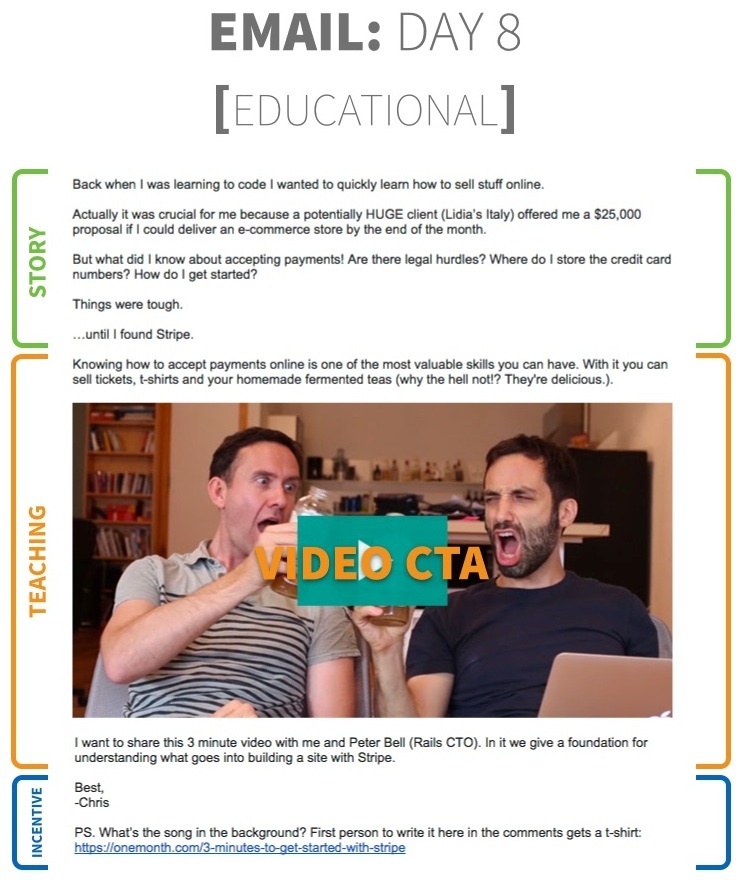
This email is broken into three parts:
1. Story: They set up the educational content by telling a quick story.
2. Education: Next they record a very nice video that teaches their readers about Stripe. This is important because it establishes One Month’s knowledge on the subject and begins a dialogue around the major pain points that their course solves.
3. Incentive: They close out the email with a very nice incentive. By giving away a t-shirt to the first person to correctly guess the background music, they get more people to watch the video.
Why would they do this?
The more people who watch the video, the more people who realize they have the issue (payment processing) that the new course solves.
Very interesting strategy.

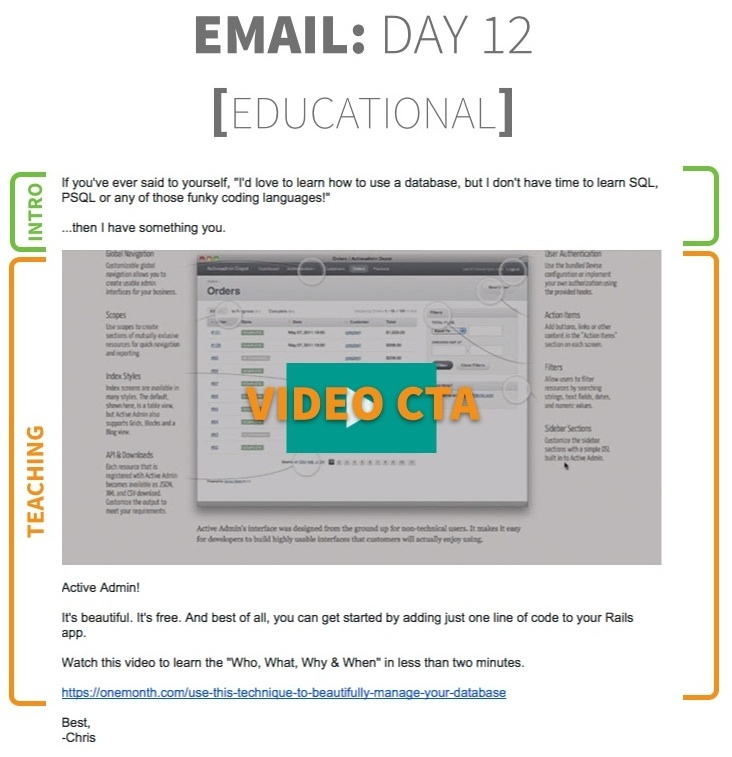
This email is straight to the point. The main call to action is to click and watch the video lesson. The lesson is focused on Active Admin, the database side of payment processing. This further establishes their expertise and makes 2 big “gives” in a row.
That’s good, because they are about to ask for something.

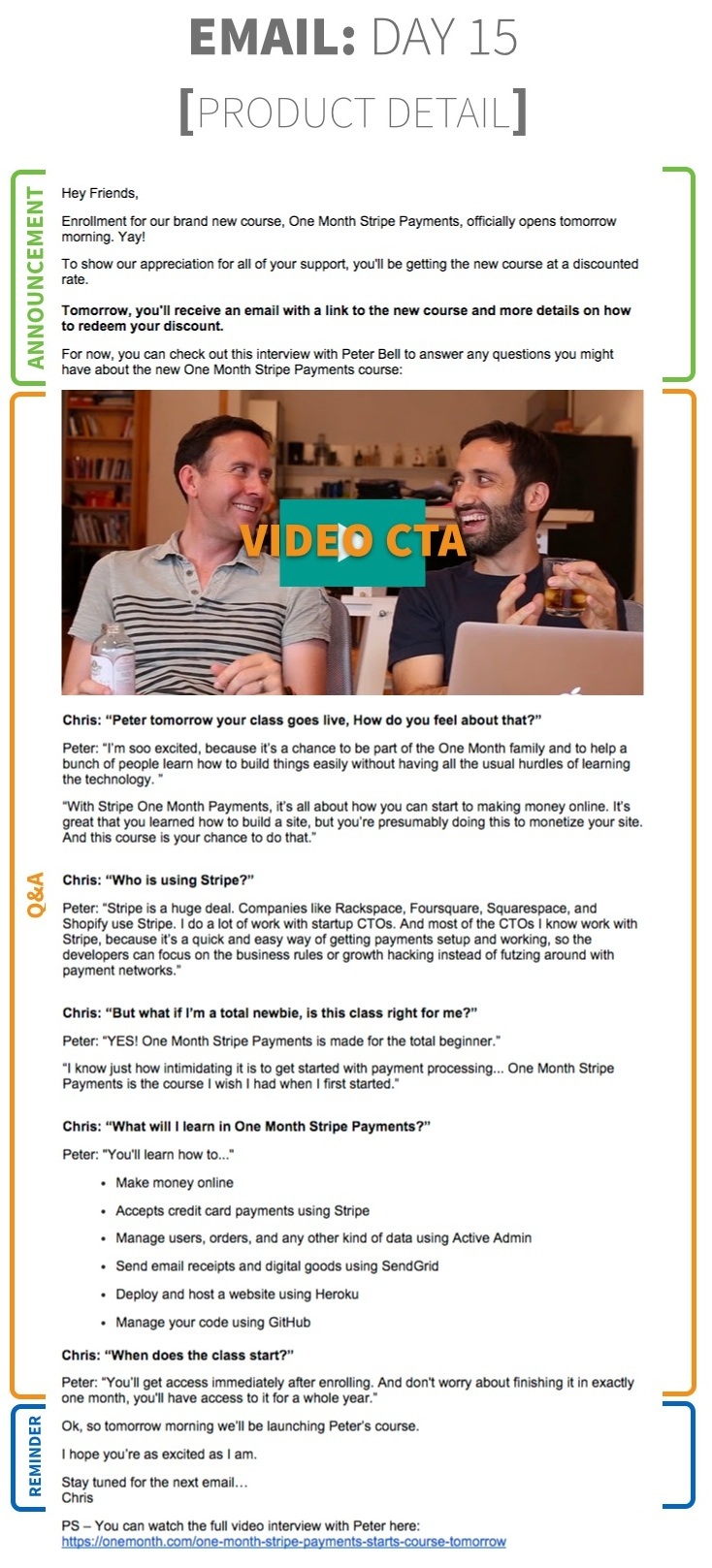
Email #1 announced the new course, One Month Stripe.
Email #2 gave the reader an introduction to Stripe.
Email #3 gave the reader an introduction to the more technical side of Stripe and payment processing.
In email #4 they switch back to talking about the course. In this video they cover the most frequently asked questions about the course. This shifts the dialogue from the free lesson given over the last week back to how the reader can learn even more through the paid course.

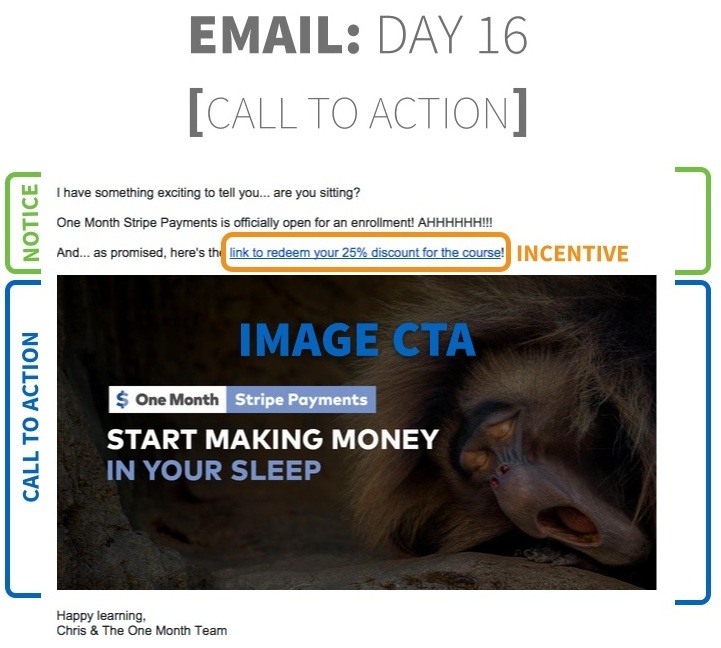
After 4 emails leading up to the release of the new course, this is the email that allows their readers to buy.
A few interesting points about this email.
1. Call to Action: The call to action in this email is a bit weak. There are two: The first is the “link to redeem…” link and the second is the giant image.
Unfortunately, neither of them use active language to tell me to buy. Something more direct like, “Click here to buy One Month Stripe” would have converted much better.
2. Brevity: I love the brevity of the launch email. This is something I see in some of the best launches. If your launch sequence has been educational and provided details on the product, your launch email doesn’t need to be long. In fact, keeping it shorter can make it easier for your readers to take action.
Be long in your education and in your product details, but short on launch day.
3. Image CTA: Personally, I love using images in the launch email. I’m not a fan of the exact image used here. But many studies have shown that using images increases the click-through rate by allowing your readers to visualize the product.
4. Urgent Coupon: The thing I like that most about this entire sequence is the time-sensitive coupon. By giving a 25% coupon that is good for only the first 24 hours, they apply a completely white-hat urgency factor to their launch. Having this coupon pushes me to make a decision.
“If I wait, I’ll have to pay 25% MORE!”
Click. Buy.

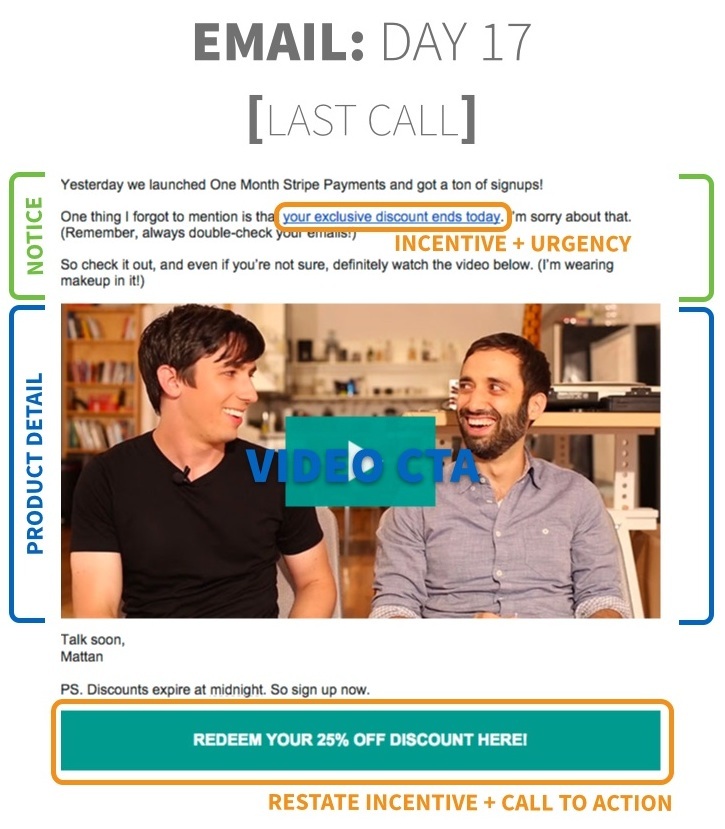
This is an email you HAVE to have in any launch.
The psychology is simple: remind them that the deal you are offering is about to expire.
I have personally seen 60%+ of my sales come within 10 hours of sending this email.
One Month does a good job of re-stating WHY you should buy and giving you a very clear call to action on HOW to buy.
How to launch with a small list
Every time I hear someone’s launch numbers I’m blown away.
“List of 18,000 makes $16,000 in 72 hours”
“List of 15,000 makes $15,000 in 24 hours”
The fact that you can press send on an email and make that kind of money is just unreal.
BUT…
What if you don’t have a big list? Can you make money with a small list?
What if you only have 5,000 subscribers? 2,000? 1,000? 500?
Friday, I’m going to introduce you to the launch sequence that I used to launch a $40,000 product with a 1,200-person list.
Also, we’ll be having a special guest on the blog. His name MIGHT rhyme with Ramit Sethi. Or not. You’ll just have to come and find out. 🙂
PS: Friday, I’ll also be giving you the first look at my new product, The Vault. It is the “secret weapon” I’ve used to grow Videofruit over the last 14 months. More on that Friday too.
